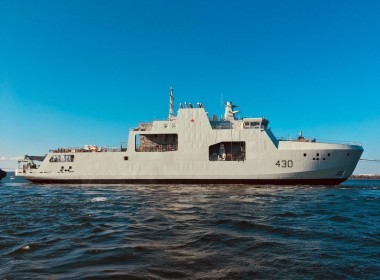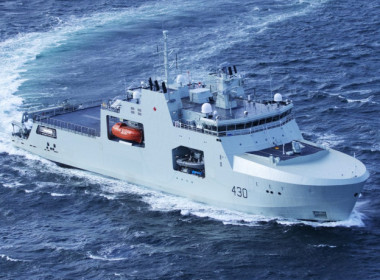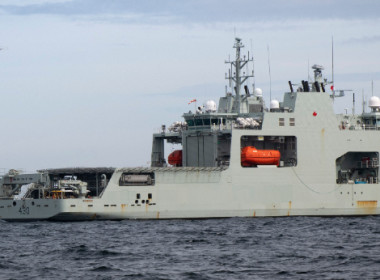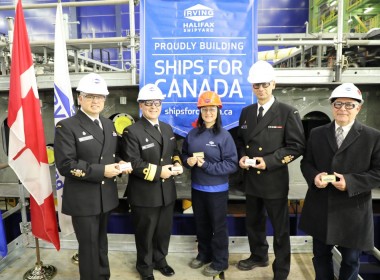VESSEL REVIEW | Harry DeWolf – Canada’s newest icebreaking patrol ship to be deployed in Arctic waters

The Royal Canadian Navy recently commissioned a new large patrol ship into service.
HMCS Harry DeWolf is the lead vessel of a new warship class designated by the navy as Arctic and Offshore Patrol Ships (AOPS). As their name implies, the ships are designed to be capable of patrols in Arctic and offshore waters within Canada’s exclusive economic zone (EEZ). The hulls were therefore designed to be compliant to IACS Polar Class 5, giving the ships limited icebreaking capability as well.
The Harry DeWolf-class is also the largest warship class currently in active service with the Royal Canadian Navy, with each AOPS boasting an LOA of 103.6 metres, a beam of 19 metres, and a displacement of 6,615 tonnes. Only the 1980s-built Halifax-class frigates exceed the AOPS in dimensions with each one measuring 134 by 16 metres, though the displacement is limited to only 4,770 tonnes.
The name for the first AOPS and the class itself was chosen in honour of Vice-Admiral Harry DeWolf, a highly decorated Canadian naval officer who saw service during World War II. During his time in command of the destroyer HMCS Haida, the ship’s crew sank 14 enemy vessels, making it the most successful in the Royal Canadian Navy in terms of enemy surface tonnage sunk.
Harry DeWolf and its five sisters were constructed at the Halifax Shipyard of Nova-Scotia-based Irving Shipbuilding as part of the National Shipbuilding Strategy (NSS), an ongoing programme wherein the current surface fleets of the Royal Canadian Navy and the Canadian Coast Guard will be replaced with newer, more capable vessels.
Harry DeWolf features a diesel-electric arrangement wherein four 3.6MW diesel engines supply electrical power for two 4.5MW propulsion motors. This enables the AOPS to sail at speeds of up to 17 knots in open water and three knots for icebreaking. A range of 12,600 kilometres is possible, allowing the ship to conduct extended patrols in the higher latitudes within its intended area of operations.
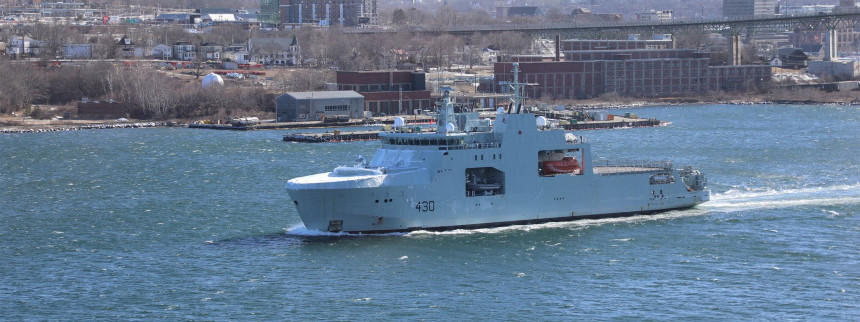
Since the AOPS is designed primarily for performing EEZ patrols, there is no need for guided missile armament, and so the only weapons on board are a BAE Systems Mark 38 25-millimetre autocannon, two pintle-mounted Browning M2 12.7-millimetre machine guns, and the crew’s arsenal of small arms. The vessel also features a flight deck and hangar for accommodating either a CH-148 Cyclone 13-tonne utility helicopter or a CH-149 Cormorant 14-tonne search and rescue (SAR) helicopter.
The AOPS is designed to be operated by a crew of 65. However, onboard accommodation spaces can house a maximum of 87 personnel should the need arise.
The ship is highly versatile thanks to its ability to transport various payloads depending on mission requirements. There is onboard space for a cargo volume equivalent to that of two standard shipping containers. The cargo may include underwater survey equipment and small vehicles such as pickup trucks, quadbikes, snowmobiles, and even a 12-metre landing craft supplied by local boatbuilder ABCO Industries. Loading and unloading are accomplished using an installed crane with a lifting capacity of 20 tonnes.
Two embarked 8.5-metre high-speed boats further enhance the AOPS’ ability to perform SAR missions. The boats will also be used for personnel transfers and at-sea boardings and inspections.
All operations including those involving the machinery and the damage control systems are monitored and controlled from the bridge with the aid of an integrated navigation system supplied by OSI Maritime Systems. A Lockheed Martin Canada combat management system has also been installed.
Construction of Harry DeWolf started at Halifax Shipyard in September 2015. The ship was delivered to the Royal Canadian Navy in July 2020 and was commissioned into service in June of this year. Sister ship HMCS Margaret Brooke, the second AOPS, was delivered to the navy earlier this month and is presently undergoing post-acceptance sea trials.
Meanwhile, two examples of a specialised unarmed variant of the AOPS are also being built by Irving for the Canadian Coast Guard.
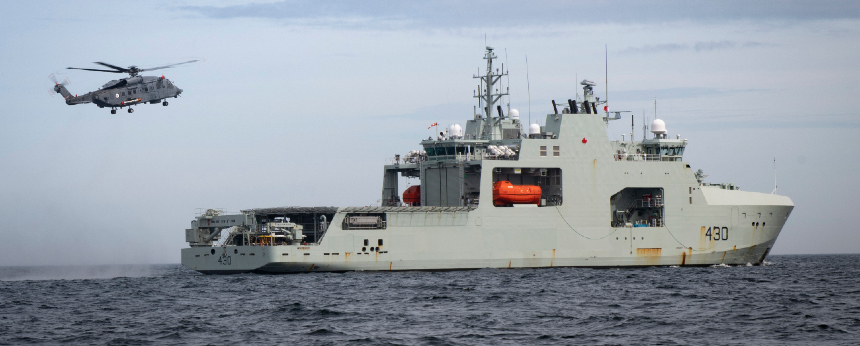
See all the other news, reviews and features of this month’s Maritime Security Week right here.
| HMCS Harry DeWolf | |
| SPECIFICATIONS | |
| Type of vessel: | Patrol ship |
| Classification: | Polar Class 5 |
| Flag: | Canada |
| Owner: | Royal Canadian Navy |
| Operator: | Royal Canadian Navy |
| Designer: | Irving Shipbuilding, Canada |
| Builder: | Irving Shipbuilding, Canada |
| Hull construction material: | Steel |
| Superstructure construction material: | Steel |
| Deck construction material: | Steel |
| Length overall: | 103.6 metres |
| Beam: | 19 metres |
| Displacement: | 6,615 tonnes |
| Capacity: | Cargo containers; underwater survey equipment; small vehicles; landing craft; helicopter |
| Main engines: | 4 x 3.6 MW |
| Auxiliary engines: | 2 x 4.5 MW |
| Maximum speed: | 17 knots |
| Range: | 12,600 kilometres |
| Other electronics: | OSI Maritime Systems integrated navigation system; Lockheed Martin Canada combat management system |
| Crane: | 1 |
| Interior fitout/furnishings: | Cargo and vehicle bay |
| Armaments: | BAE Systems 25mm autocannon; 2 x Browning 12.7mm machine guns |
| Rescue boat/s: | 2 |
| Tenders: | ABCO Industries landing craft |
| Type of fuel: | Diesel |
| Crew: | 65 |
| Passengers: | 22 |




